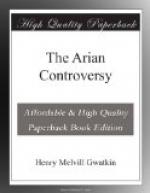[Sidenote: Arianism condemned.]
The Arians must have come full of hope to the council. So far theirs was the winning side. They had a powerful friend at court in the Emperor’s sister, Constantia, and an influential connection in the learned Lucianic circle. Reckoning also on the natural conservatism of Christian bishops, on the timidity of some, and on the simplicity or ignorance of others, they might fairly expect that if their doctrine was not accepted by the council, it would at least escape formal condemnation. They hoped, however, to carry all before them. An Arianizing creed was therefore presented by a score or so of bishops, headed by the courtier Eusebius of Nicomedia. They soon found their mistake. The Lord’s divinity was not an open question in the churches. The bishops raised an angry clamour and tore the offensive creed in pieces. Arius was at once abandoned by nearly all his friends.
[Sidenote: Eusebius proposes the creed of Caesarea.]
This was decisive. Arianism was condemned almost unanimously, and nothing remained but to put on record the decision. But here began the difficulty. Marcellus and Athanasius wanted it put into the creed, but the bishops in general saw no need of this. A heresy so easily overcome could not be very dangerous. There were only half a dozen Arians left in the council, and too precise a definition might lead to dangers on the Sabellian side. At this point the historian Eusebius came forward. Though neither a great man nor a clear thinker, he was the most learned student of the East. He had been a confessor in the persecution, and now occupied an important see, and stood high in the Emperor’s favour. With regard to doctrine, he held a sort of intermediate position, regarding the Lord not indeed as a creature, but as a secondary God derived from the will of the Father. This, as we have seen, was the idea then current in the East, that it is possible to find some middle term between the creature and the highest deity. To a man of this sort it seemed natural to fall back on the authority of some older creed, such as all could sign. He therefore laid before the council that of his own church of Caesarea, as follows:—
We believe in one God, the Father Almighty,
maker of all things, both
visible and invisible;
And in one Lord Jesus Christ,
the Word of God,
God from God,
light from light,
life from life,
the only-begotten Son,
the first-born of all creation,
begotten of the Father before
all ages,—
by whom also all things were
made;
who for our salvation was made flesh,
and lived among men,
and suffered,
and rose again the third day,
and ascended to the Father,
and shall come again in glory,
to judge quick
and dead;
And in the Holy Spirit.




